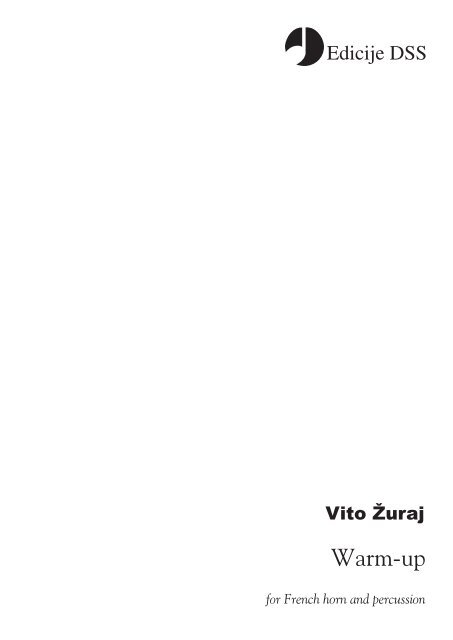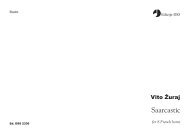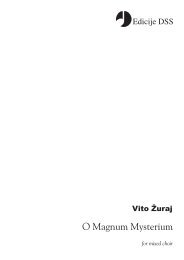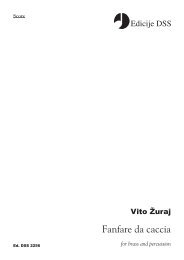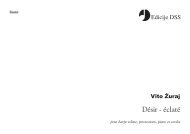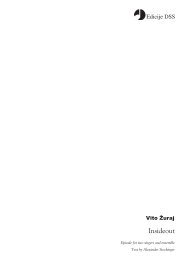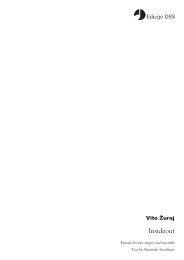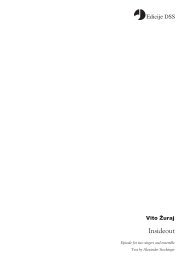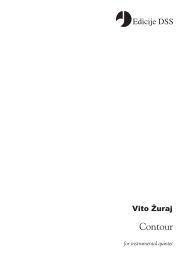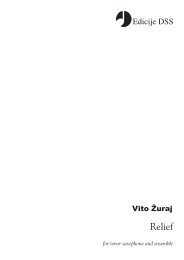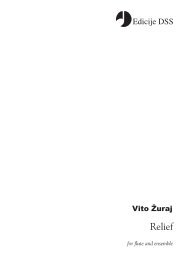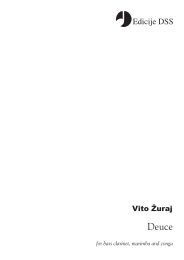Vito Žuraj - Warm-up
for French horn and percussion ©2012 by Edicije DSS
for French horn and percussion
©2012 by Edicije DSS
You also want an ePaper? Increase the reach of your titles
YUMPU automatically turns print PDFs into web optimized ePapers that Google loves.
<strong>Vito</strong> <strong>Žuraj</strong> (*1979):<br />
<strong>Warm</strong>-<strong>up</strong> for French horn and percussion (Karlsruhe, 2012)<br />
Duration: approx. 10 min.<br />
World première: 13th March 2012<br />
Slovenian Philharmonic, Kozina Hall, Ljubljana<br />
Saar Berger, French horn<br />
Percussion Ensemble SToP: Franci Krevh, Matevž Bajde<br />
Recommended work at the 2012 International Rostrum of Composers<br />
Performers<br />
French horn in F<br />
percussion - 2 players:<br />
I (left):<br />
II (right):<br />
bass marimba (down to low C), alto kalimba (15 tones: g-g“, amplified if possible),<br />
small splash suspended cymbal, bass drum,<br />
spring drum, wooden box, 3 hand drums, 3 metal tubes, 3 wooden bars, 3 woodblocks<br />
vibraphone, crotales (1 octave), tam-tam (low), anvil (low),<br />
spring drum, wooden box, 3 hand drums, 3 metal tubes, 3 wooden bars, 3 woodblocks<br />
All wooden bars, metal tubes, hand drums, woodblocks, spring drums and wooden boxes should be of different sizes and pitches.<br />
Mc. DSS 107<br />
© 2012 by Edicije DSS, Ljubljana, Slovenia<br />
http://www.dss.si<br />
Notation & Design: <strong>Vito</strong> <strong>Žuraj</strong><br />
http://www.vitozuraj.com
Percussion symbols<br />
´ CROTALES (1 OCTAVE)<br />
√ VIBRAPHONE<br />
µ BASS MARIMBA (down to C3)<br />
3 METAL TUBES<br />
3 WOODEN BARS<br />
3 HAND DRUMS<br />
SSS 3 WOODBLOCKS<br />
E<br />
∫<br />
ˇ<br />
ç<br />
Ç<br />
‡[<br />
j<br />
LARGE WOODEN BOX<br />
BASS DRUM<br />
TAM-TAM (LOW, THIN METAL)<br />
ANVIL (LOW)<br />
SUSPENDED CYMBAL, SMALL SPLASH<br />
KALIMBA (15 TONES)<br />
SPRING DRUM<br />
Mallets<br />
^ BASS DRUM BEATER, SOFT<br />
‹ RATTAN YARN MALLET, HARD<br />
⁄ RATTAN YARN MALLET, SOFT<br />
£ PLASTIC MALLET, HARD<br />
N<br />
– DOUBLE BASS BOW<br />
THREADED STICK („REIBSTOCK“)<br />
% TUBULAR BELL HAMMER<br />
c<br />
ANVIL HAMMER<br />
) TRIANGLE BEATER<br />
! TAM-TAM BEATER, SOFT<br />
Ù<br />
f<br />
SUPERBALL<br />
TEASPOON<br />
Explanation of articulation signs and other symbols<br />
.<br />
˘<br />
All staccato or accentuated staccato markings in this piece are to be played extremely short.<br />
The length of such notes should remain uniform throughout the piece, independently of whether<br />
they be quarter, eighth, sixteenth-notes or other durations.<br />
/<br />
><br />
æ<br />
fi<br />
*<br />
ö<br />
repeat the note twice / thrice as quickly as possible and extremely short<br />
common accent at the beginning of a long note<br />
tremolo is to be performed as fast as possible<br />
general sign for muting (strings and percussion)<br />
general for cancelling the muting (strings and percussion)<br />
no audible attack at beginnings of notes: soft bass drum beaters should be employed in the lower<br />
registers of the bass marimba and vibraphone such that only the resonance of the bars is audible<br />
Notation for metal tubes, wooden bars and hand drums<br />
¿<br />
‚<br />
œ<br />
metal tubes<br />
wooden bars (WOOD)<br />
hand drums (SKIN)<br />
(METAL)<br />
Example of notation<br />
for metal tubes, wooden<br />
bars and hand drums:<br />
Tuning of kalimba<br />
Notation<br />
Sound<br />
Example of notation:


